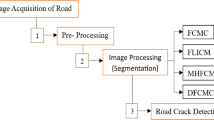Abstract
Edge detection is a phenomenon that is utilized to identify discontinuity, roughness, and boundaries in a variety of engineering and scientific problems. The edge detection phenomenon is dependent on image quality measures such as blur, noise, and edge strength, and making it difficult to identify and detect proper edges. Traditional edge detection algorithms are based on pixel gradients and have number of flaws, including false edge acceptance and rejection. To deal these issues in this paper, an edge detection method based on edge preserving guided filtering along with fuzzy logic is presented. Edge preserving guided filtering preserves edges and smoothened background while fuzzy logic is used for edge detection. In this work type-1, fuzzy logic is considered. The presented methods are based on soft computing or holistic approaches, which are computationally intensive, and edge detection accuracy is dependent on the learning strategy, fitness function, and precise tweaking of learning parameters.














Similar content being viewed by others
References
Petrou MM, Petrou C (2010) Image processing: the fundamentals. Wiley, London
Bovik AC (2010) Handbook of image and video processing. Academic Press, London
Shah M (1997) Fundamentals of computer vision. University of Central Florida
Gevers T, Gijsenij A, Van de Weijer J, Geusebroek JM (2012) Color in computer vision: fundamentals and applications, vol 23. Wiley, London
Shih FY (2010) Image processing and pattern recognition: fundamentals and techniques. Wiley, London
Kanopoulos N, Vasanthavada N, Baker RL (1988) Design of an image edge detection filter using the Sobel operator. IEEE J Solid-State Circuits 23(2):358–367
Clark JJ (1989) Authenticating edges produced by zero-crossing algorithms. IEEE Trans Pattern Anal Mach Intell 11(1):43–57
Marr D, Hildreth E (1980) Theory of edge detection. Proc R Soc Lond Ser B Biol Sci 207(1167):187–217
Canny J (1986) A computational approach to edge detection. IEEE Trans Pattern Anal Mach Intell 6:679–698
Gao W, Zhang X, Yang L, Liu H (2010) An improved Sobel edge detection. In: 2010 3rd international conference on computer science and information technology, vol 5, pp 67–71. IEEE
Shanmugavadivu P, Kumar A (2013) Boundary detection of objects in digital images using bit-planes and threshold modified canny method. In: Mining intelligence and knowledge exploration, pp 192–200. Springer, Cham
Aborisade DO (2010) Fuzzy logic based digital image edge detection. Glob J Comput Sci Technol 10(14):78–83
Hien NM, Binh NT, Viet NQ (2017) Edge detection based on Fuzzy C Means in medical image processing system. In: 2017 international conference on system science and engineering (ICSSE), pp 12–15. IEEE
Alshennawy AA, Aly AA (2009) Edge detection in digital images using fuzzy logic technique. Int J Comput Inform Eng 3(3):540–548
Farbod M, Akbarizadeh G, Kosarian A, Rangzan K (2018) Optimized fuzzy cellular automata for synthetic aperture radar image edge detection. J Electron Imaging 27(1):013030
Kumar A, Raheja S (2020) Edge detection using guided image filtering and ant colony optimization. In: The international conference on recent innovations in computing, pp 319–330. Springer, Singapore
Kumar A, Raheja S (2020) Edge detection using guided image filtering and enhanced ant colony optimization. Proc Comput Sci 173:8–17
Ari S, Ghosh DK, Mohanty PK (2014) Edge detection using ACO and F ratio. SIViP 8(4):625–634
Verma OP, Hanmandll M, Kumar P, Srivastava S (2009) A novel approach for edge detection using antcolony optimization and fuzz derivative technique. In: 2009 IEEE international advance computing conference, pp 1206–1212. IEEE
Wu J, Yin Z, **ong Y (2007) The fast multilevel fuzzy edge detection of blurry images. IEEE Signal Process Lett 14(5):344–347
Verma OP, Hanmandlu M, Kumar P, Chhabra S, **dal A (2011) A novel bacterial foraging technique for edge detection. Pattern Recogn Lett 32(8):1187–1196
Sun G, Liu Q, Liu Q, Ji C, Li X (2007) A novel approach for edge detection based on the theory of universal gravity. Pattern Recogn 40(10):2766–2775
Verma OP, Sharma R (2012) Newtonian gravitational edge detection using gravitational search algorithm. In: 2012 International conference on communication systems and network technologies, pp 184–188. IEEE
Kumar A, Raheja S (2021) Edge detection in digital images using guided L0 smoothen filter and fuzzy logic. Wireless Pers Commun 121(4):2989–3007
Xu L, Lu C, Xu Y, Jia J (2011) Image smoothing via L0 gradient minimization. ACM Trans Graph (TOG) 30(6):1–12
He K, Sun J, Tang X (2012) Guided image filtering. IEEE Trans Pattern Anal Mach Intell 35(6):1397–1409
Sun X, Liu H, Wu S, Fang Z, Li C, Yin J (2017) Low-light image enhancement based on guided image filtering in gradient domain. Int J Digit Multimed Broadcast. https://doi.org/10.1155/2017/9029315
Author information
Authors and Affiliations
Corresponding author
Rights and permissions
Springer Nature or its licensor holds exclusive rights to this article under a publishing agreement with the author(s) or other rightsholder(s); author self-archiving of the accepted manuscript version of this article is solely governed by the terms of such publishing agreement and applicable law.
About this article
Cite this article
Ranjan, R., Avasthi, V. A hybrid edge detection mechanism based on edge preserving filtration and type-1 fuzzy logic. Int. j. inf. tecnol. 14, 2991–3000 (2022). https://doi.org/10.1007/s41870-022-01059-9
Received:
Accepted:
Published:
Issue Date:
DOI: https://doi.org/10.1007/s41870-022-01059-9




